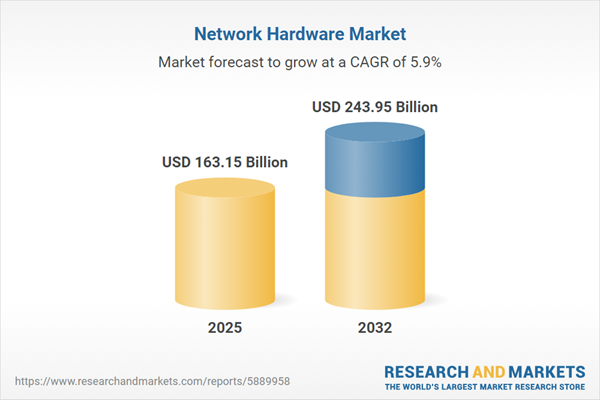Speak directly to the analyst to clarify any post sales queries you may have.
As enterprise IT environments digitalize, demand for advanced network hardware becomes vital for supporting transformation initiatives. For senior decision-makers, deploying resilient, secure, and scalable network infrastructure underpins operational continuity, business agility, and risk mitigation, making strategic hardware selection a core organizational priority.
Market Snapshot: Network Hardware Market Growth Drivers
The global network hardware market is experiencing steady expansion, fueled by rising enterprise IT workloads and faster adoption of advanced connectivity technologies. This growth reflects critical business needs: high-speed, reliable connectivity and robust cybersecurity across sectors. The increased reliance on automated and integrated systems shapes procurement choices, especially as organizations with distributed teams face evolving compliance requirements. As hybrid workplaces become prevalent, enterprises are prioritizing network hardware that offers flexible deployment and reliability, meeting regulatory obligations and supporting global and local operations.Scope & Segmentation: Detailed Analysis of the Network Hardware Market
This report delivers strategic intelligence to senior leaders charged with network infrastructure planning and procurement, enabling alignment between IT investments and broader business goals. The following segments define the market landscape and technology adoption:
- Product Types: Indoor and outdoor access points, edge and core routers, managed and unmanaged switches, next-generation firewalls, and unified threat management devices. Each plays a role in creating secure, responsive, and business-aligned networking environments.
- Components: Active switches and routers, passive elements, management software, and support services. These ensure continuous uptime and support optimal service delivery for enterprise workloads.
- End Users: Sectors include banking, insurance, capital markets, education, energy, public sector, healthcare, information technology, retail, manufacturing, telecommunications, ISPs, and mobile operators. Each faces specific compliance needs and operational imperatives.
- Organization Size: Hardware solutions are tailored for startups, SMBs, and large enterprises. Differences in scale, agility, and operational requirements guide procurement strategies and deployment choices.
- Deployment Models: Options span public, private, and hybrid cloud, alongside on-premise architectures. These enable flexible responses to regulatory and geographic demands for organizations of varying scale.
- Connectivity Types: Wired options and wireless solutions, including Wi-Fi, cellular, Zigbee, and Bluetooth, deliver adaptable integration for both remote and onsite workflows.
- Regions Covered: Markets in the Americas, Europe, Asia-Pacific (China, India, Japan, Australia, Southeast Asia), Middle East, and Africa are shaped by infrastructure maturity and regulatory environments.
- Company Analysis: Evaluation of Cisco Systems, Huawei, Hewlett Packard Enterprise, Juniper Networks, Dell Technologies, Nokia, Arista Networks, Ciena, ZTE, and Extreme Networks—each pursues distinct innovation strategies and technology offerings.
Key Takeaways for Senior IT Decision-Makers
- Automated and secure network hardware positions organizations to adapt rapidly to operational changes, strengthening resilience when conditions shift or scale requirements grow.
- Software-defined networking and AI-powered edge solutions improve network management and reliability, especially for teams working across multiple locations.
- Combining legacy and modern hardware reduces integration risks and streamlines transitions during system upgrades or migrations.
- Industries with high compliance needs increasingly invest in advanced infrastructure to boost performance and meet evolving regulatory demands.
- Procurement strategies reflect regional differences and availability, pushing organizations to seek adaptable approaches for stability and expansion.
- Effective deployment of comprehensive technology portfolios supports network investments that are tightly integrated with business priorities and capital strategies.
Tariff Impact: Supply Chain and Procurement Considerations
Forthcoming United States tariff increases in 2025 are set to influence network hardware sourcing and procurement. Anticipated cost rises prompt organizations to re-evaluate supplier relationships and hardware lifecycle management. Renegotiating service agreements and implementing proactive tariff strategies will be crucial for ensuring infrastructure stability, compliance, and budget predictability amid ongoing trade changes.
Methodology & Data Sources
Findings in this report are derived from executive interviews, specialist input, regulatory analysis, and comprehensive supplier data. All recommendations are validated through proprietary and independent peer-reviewed sources, equipping leaders with reliable intelligence for enterprise-level network hardware choices.
Why This Network Hardware Market Research Report Matters
- Presents a segmented view of the network hardware market, enabling efficient supplier evaluation and informed capital allocation.
- Prepares decision-makers to address market fluctuations, compliance obstacles, and foster collaboration with strategic partners.
- Delivers insights into operational, compliance, and geopolitical risks, supporting assured decision-making in complex network hardware contexts.
Conclusion
This report equips leaders with critical segmentation and actionable guidance for risk-aware, effective network hardware investments. The analysis supports long-term resilience and stability during rapidly changing technology cycles.
Additional Product Information:
- Purchase of this report includes 1 year online access with quarterly updates.
- This report can be updated on request. Please contact our Customer Experience team using the Ask a Question widget on our website.
Table of Contents
3. Executive Summary
4. Market Overview
7. Cumulative Impact of Artificial Intelligence 2025
Companies Mentioned
The companies profiled in this Network Hardware market report include:- Cisco Systems, Inc.
- Huawei Technologies Co., Ltd.
- Hewlett Packard Enterprise Company
- Juniper Networks, Inc.
- Dell Technologies Inc.
- Nokia Oyj
- Arista Networks, Inc.
- Ciena Corporation
- ZTE Corporation
- Extreme Networks, Inc.
Table Information
| Report Attribute | Details |
|---|---|
| No. of Pages | 187 |
| Published | November 2025 |
| Forecast Period | 2025 - 2032 |
| Estimated Market Value ( USD | $ 163.15 Billion |
| Forecasted Market Value ( USD | $ 243.95 Billion |
| Compound Annual Growth Rate | 5.9% |
| Regions Covered | Global |
| No. of Companies Mentioned | 11 |









